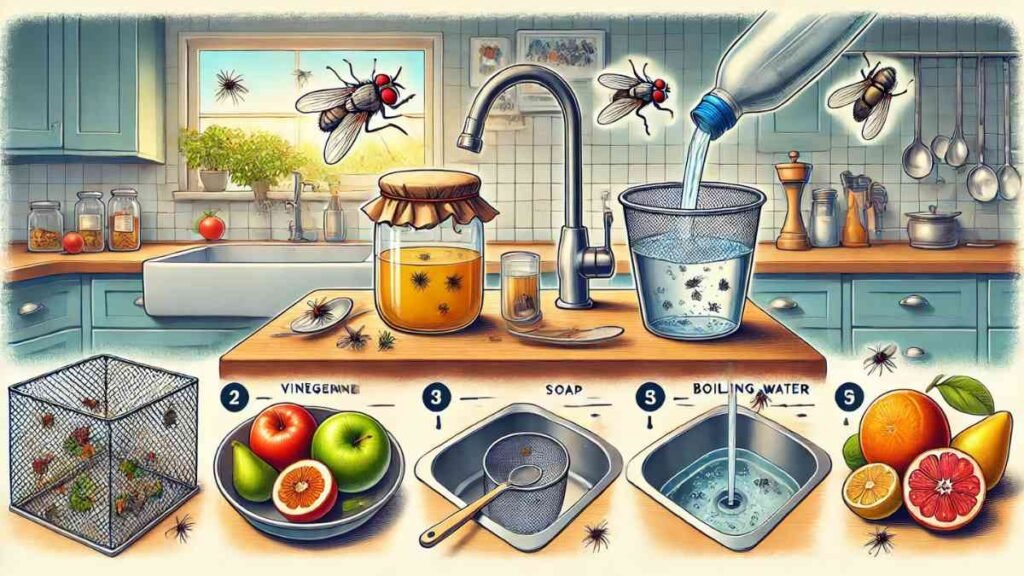Fruit flies are among the most persistent household pests, thriving in homes where ripe fruits, vegetables, or fermenting residues are present. Their rapid reproduction and ability to multiply make them a nuisance. In this comprehensive guide, you’ll learn effective strategies to eliminate fruit flies and prevent their return.
Understanding Fruit Flies and Their Habits
What Attracts Fruit Flies?
Fruit flies are primarily attracted to:
- Ripe or fermenting fruits and vegetables.
- Residues in garbage disposals and drains.
- Open beverage containers, especially alcohol or sugary drinks.
Why Are They So Persistent?
Fruit flies reproduce rapidly. A single female can lay up to 500 eggs at a time, with larvae developing into adults within a week.
Step 1: Eliminate Breeding Grounds
Dispose of Overripe or Damaged Produce
Start by removing overripe or damaged fruits and vegetables from your kitchen. Store fresh produce in the refrigerator or sealed containers.
Clean Garbage and Recycling Bins
- Empty bins regularly.
- Wash bins with soapy water and disinfectant to remove residue.
Sanitize Surfaces
Wipe down kitchen counters, tables, and shelves to eliminate crumbs or spills. Pay special attention to cracks or hard-to-reach corners.
Unclog and Clean Drains
Pour a mixture of boiling water and baking soda into drains to eliminate eggs or larvae breeding in moist conditions.
Step 2: Set Up Effective Fruit Fly Traps
Apple Cider Vinegar Trap
This trap is one of the simplest and most effective:
- Fill a bowl with apple cider vinegar.
- Add a few drops of dish soap.
- Leave it uncovered near the fruit flies’ hotspots. The vinegar attracts them, and the soap traps them.
Jar and Paper Cone Trap
For a DIY solution:
- Place a piece of overripe fruit in a jar.
- Create a cone using a piece of paper and insert it into the jar, narrow end down.
- Fruit flies will enter but won’t be able to escape.
Sticky Tape
Hang sticky fly paper near areas with heavy fruit fly activity. The flies will get stuck, helping you monitor and reduce their population.
Step 3: Prevent Future Infestations
Refrigerate Produce
Storing fruits and vegetables in the fridge limits their exposure to fruit flies.
Cover Food and Drinks
Keep lids on jars, bottles, and leftover food to prevent access to attractive items.
Use Airtight Containers
Store pantry staples like sugar, flour, and other dry goods in sealed containers.
Maintain a Regular Cleaning Routine
- Wipe down surfaces daily.
- Avoid leaving dirty dishes in the sink.
- Clean appliances, especially microwaves and toasters.
Step 4: Address Lesser-Known Breeding Spots
Potted Plants
Overwatering plants can create a breeding ground for fruit flies. Allow the soil to dry between waterings.
Pet Food and Water Bowls
Clean pet bowls daily to remove residues that might attract fruit flies.
Compost Bins
Ensure your compost bin is tightly sealed and emptied frequently.
Step 5: Use Natural Repellents
Essential Oils
Fruit flies dislike the smell of certain essential oils, such as:
- Lemongrass
- Eucalyptus
- Peppermint
Mix a few drops with water in a spray bottle and use it to mist your kitchen and dining areas.
Herbs
Place basil, mint, or rosemary near fruit bowls or windows to repel fruit flies naturally.
Step 6: Monitor for Reoccurrence
Check Regularly
Inspect frequently visited areas like garbage disposals, drains, and countertops to ensure they remain free of flies.
Replace Traps
Swap out vinegar traps and other DIY solutions weekly for maximum effectiveness.
Professional Pest Control
If an infestation persists despite your efforts, consider contacting a pest control expert for assistance.
Conclusion
Eliminating fruit flies requires consistent effort and attention to detail. By removing their breeding grounds, setting up effective traps, and maintaining a clean environment, you can enjoy a fruit-fly-free home. Follow these tips to tackle infestations effectively and prevent future occurrences.
For More Visit, MirrorMagazine.co.uk


